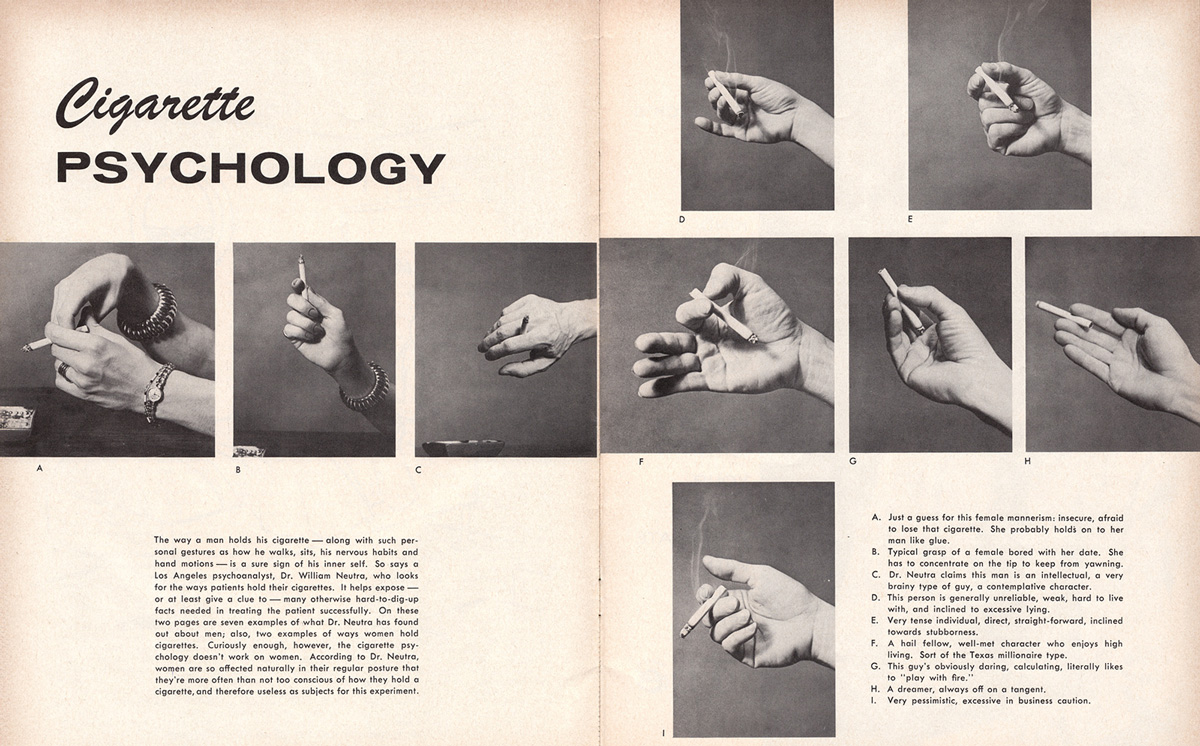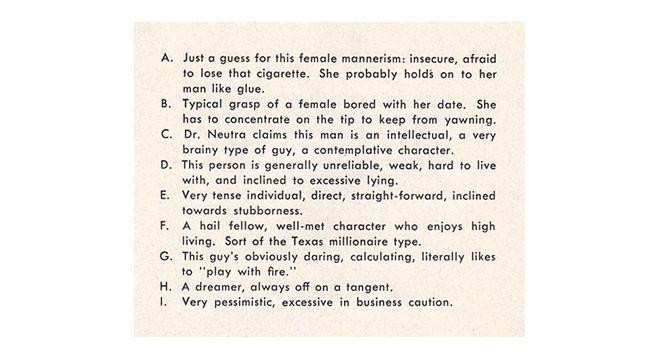smoking
No one speaks English, and everything’s broken

As men are generally more short-term oriented in their sexuality than women, and given that cigarette and alcohol use are still considered masculine behaviors, we explored if female smoking and drinking can function as a short-term mating strategy. […]
The experiment showed that young men perceive women who use cigarettes and alcohol as being more sexually unrestricted. Furthermore, tobacco and (especially) alcohol use brought some short-term attractiveness benefits to women. In short-term mating contexts, drinking enhanced women’s attractiveness, whereas occasional smoking was found equally desirable as not smoking. However, in long-term mating contexts, frequent drinking and all smoking behavior harmed women’s desirability.
The rain falls hard on a humdrum town, this town has dragged you down
Group 1 - Carcinogenic:
This is the group for which there is the most evidence of cancer risk. […]
• Arsenic and arsenic compounds
[…]
• Solar radiation
• Tamoxifen6
• Tobacco, smoking, second-hand smoke
• Ultraviolet radiation
• X-Radiation and gamma radiation
• Processed meat[…]
Group 2A - Probably carcinogenic:
Limited evidence of carcinogenicity in humans, sufficient evidence of carcinogenicity in experimental animals. […]
• Shift work that disrupts sleep patterns
• Red meat[…]
Group 2B - Possibly carcinogenic:
Limited evidence of carcinogenicity in humans, less than sufficient evidence of carcinogenicity in experimental animals. […]
• Magenta dyes
• Pickled vegetables
My name’s Elvira but you can call me tonight

State-of-the-art forensic technology from South Africa has been used to try and unravel the mystery of what was smoked in tobacco pipes found in the Stratford-upon-Avon garden of William Shakespeare.
Residue from clay tobacco pipes more than 400 years old from the playwright’s garden were analysed. […] Results of this study (including 24 pipe fragments) indicated cannabis in eight samples, nicotine in at least one sample, and in two samples definite evidence for Peruvian cocaine from coca leaves.
Foot and mouth disease too
Do not smoke and do not allow yourself to be exposed to smoke because second-hand smoke and third-hand smoke are just as deadly as first-hand smoke, says a scientist at the University of California, Riverside who, along with colleagues, conducted the first animal study of the effects of third-hand smoke.
While first-hand smoke refers to the smoke inhaled by a smoker and second-hand smoke to the exhaled smoke and other substances emanating from the burning cigarette that can get inhaled by others, third-hand smoke is the second-hand smoke that gets left on the surfaces of objects, ages over time and becomes progressively more toxic.
related:
Evil is suffering passed to someone else
A study has found for the first time that thirdhand smoke — the noxious residue that clings to virtually all surfaces long after the secondhand smoke from a cigarette has cleared out — causes significant genetic damage in human cells.
Death by misadventure
We all know that smoking is bad for our health and that eating vegetables is good for it. Yet how bad and how good are they? […]
To answer his own question, Spiegelhalter converted reams of statistical risk tables into a simple metric: a microlife—30 minutes. If you smoke two cigarettes, you lose 30 minutes of your life. Exercise for 20 minutes, and you gain two units of microlife.
The warmth of her couched body rose on the air, mingling with the fragrance of the tea she poured

The more alcoholic drinks people consume, the more attractive they perceive themselves to be. […]
First, women with high levels of estrogen feel prettier, and second, smoking causes a lowered presence of estrogen in your body. So if you’re a female smoker and want to feel more attractive, boost your estrogen levels and stop smoking. Additionally this hormone helps maintain your female features and is vital to your body’s fertility.
photo { Bill Brandt }
‘The easier it is to do, the harder it is to change.’ –Eng’s Principle

Nicotine is not only very, very addictive, as a central nervous system stimulant it can also affect our motivations and behaviors in a wider sense. One of the behaviors it can modify is appetitive behavior. It’s a well-funded fact that smokers tend to have a lower body-mass than non-smokers, and that smokers who quit have a tendency to gain weight, although until now the neurobiological mechanism for this modulation was unknown.
Recent findings from two different publications reveal parts of this mechanism, but while most reports have pin-pointed the results involving appetite suppression through pro-opiomelanocortin neurons, there is evidence that the complete picture is more complicated than that.
photo { Penny Cottee }
We’re all unlucky in love sometimes. When I am, I go jogging. The body loses water when you jog, so you have none left for tears.

{ I’ve just come across a deeply disturbing paper: Attempted ignition of petrol vapour by lit cigarettes and lit cannabis resin joints. The authors set out to discover whether you could set petrol on fire by dropping a lit cigarette or hash joint onto it. It turns out, surprisingly, that you can’t. | Neuroskeptic | full story }
There is (as I shall show in what follows) another, third kind
Scientists are reporting that so-called “thirdhand smoke” — the invisible remains of cigarette smoke that deposits on carpeting, clothing, furniture and other surfaces — may be even more of a health hazard than previously believed. (…)
Studies show that that nicotine in thirdhand smoke can react with the ozone in indoor air and surfaces like clothing and furniture, to form other pollutants. Exposure to them can occur to babies crawling on the carpet, people napping on the sofa, or people eating food tainted by thirdhand smoke.
Next thing you know you yawnin’

Quitting smoking is certainly healthy for the body, but doctors and scientists haven’t been sure whether quitting makes people happier, especially since conventional wisdom says many smokers use cigarettes to ease anxiety and depression. In a new study, researchers tracked the symptoms of depression in people who were trying to quit and found that they were never happier than when they were being successful, for however long that was.
related { Smoking may thin the brain }
photo { Paul Rodriguez }
‘In advanced economies, recipes are more valuable than cooking.’ –Paul Romer

[$12 a pack] It’s been six weeks since New York’s state government raised the cigarette tax to $4.35 a pack, and guess what? Cigarette sales have fallen by 35 percent. (…)
The crazy-high price of cigarettes here is sending New Yorkers over the state border to, say, Pennsylvania, where a pack of cigarettes can be obtained for around $5, or Jersey, where they’re $7ish. People are also heading to Indian reservations, where, according to a friend who does exactly this, you can get a carton for $22, and where sales have apparently gone up a whopping 300%.
photo { Petra Collins }
It’s all the streets you crossed, not so long ago
The promise—and the hype—of changing your DNA through behavior.
Studies showing how experience alters genes have been few and far between—which is why a new one on smoking and diet caught my eye.
The study of these kinds of changes in genes is called epigenetics. Crucially, the changes do not involve alterations of gene sequences, those famous A’s, T’s, C’s, and G’s that the Human Genome Project figured out. (…)
Scientists are now making specific, actionable discoveries in epigenetics. This week, for instance, researchers are reporting that eating leafy green vegetables, folate (found in these veggies as well as in some fruits and in dried beans and peas), and multivitamins can affect the epigenetics of genes involved in lung cancer in a way that could reduce the risk of getting the disease, especially from smoking.
Wrapped the hills in a blanket of Patterson’s curse

You might have seen news reports about a recent study showing that religious people are no healthier than non-religious. (…)
Working out the relationship between religion and health is actually quite complicated. If you take the straightforward approach the answer is clear: religious people are unhealthier and die younger than the non-religious.
The reason for that is obvious. Religious people tend to be poorer and less well educated. As a result, most studies try to work out whether religious people are healthier after adjusting for these differences.
So the key question boils down to this: which differences should you adjust for? Your decision on this will affect the answer you get. (…)
Most studies adjust for basic demographic factors. Older people and women are more likely to be religious, and both these affect your chances of heart attacks. Most studies also adjust for education and income level. (…)
But there are also a host of lifestyle factors that make heart disease more likely (smoking, lack of exercise, overeating). Here’s where it starts to get more difficult, because religion could definitely cause you to be a nonsmoker.
Many studies adjust for these lifestyle factors. But you can go a step further - and that’s what they did in this study. (…)They found that religious people smoked less. This was one of only two lifestyle factors that remained after they adjusted for all the demographic differences between the religious and non-religious (age, gender, race, education and income). That’s something that’s commonly observed, and it may be because religion provides social pressure and support to help people quit.
But the study also found that religious people were fatter (again, after adjusting for demographic factors). The effect was large - religious people were 50-60% more likely to be obese.
photo { Katerina Jebb }
And the words Sic transit gloria mundi are recited

{ Tobacco Smoke Enema (1750s-1810s) | via Barry Ritholz | Read more: Wikipedia }
Moving forward is about progress, not perfection

The movement to ban smoking in New York City has grown so quickly that no place seems immune — certainly not restaurants or bars, and public beaches and parks may not be far behind. Now the efforts are rapidly expanding into the living room.
More landlords are moving to prohibit smoking in their apartment buildings, telling prospective tenants they can be evicted if they light up in them. (…)
And the typical smoker’s refuge — directly outside the building — is also off limits; tenants must agree not to smoke on any of the sidewalks that wrap around the building.
The hardest years in life are those between ten and seventy

{ A Dallas woman has filed a lawsuit seeking six figures from a former neighbor and landlord for damage she says was caused by cigarette smoke wafting through adjoining walls of her high-end townhome. Cary Daniel and her mother Chris Daniel no longer live in the townhome, and said they need to wear respirators and goggles when they return to the townhome to retreive their belongings. | Dallas News | full story }











